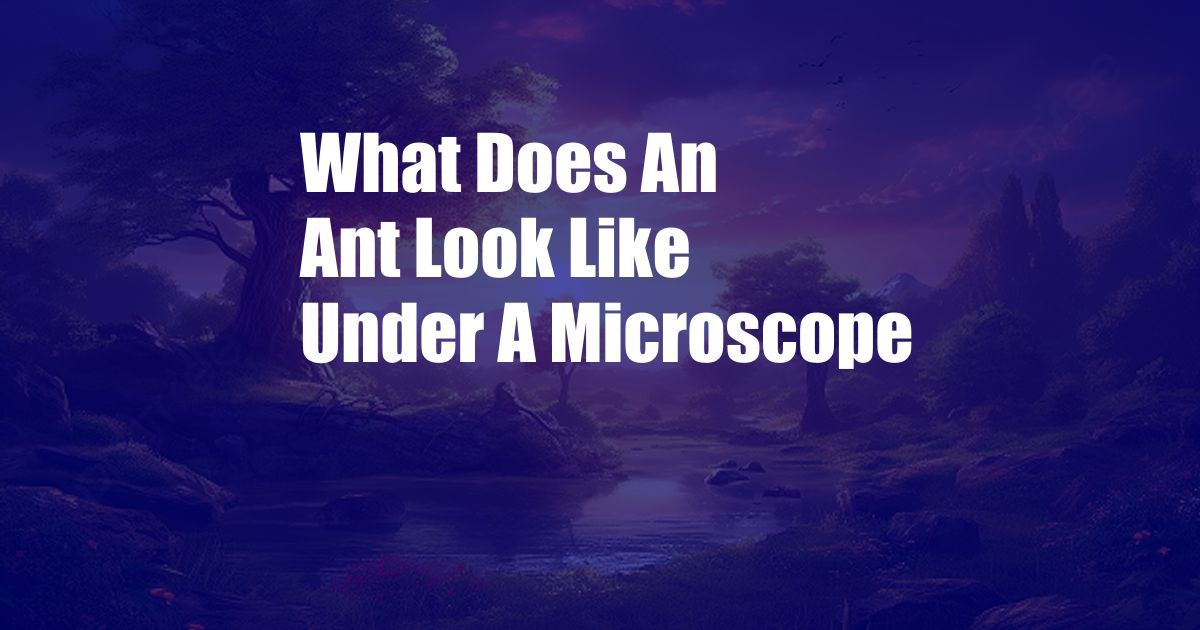
What Does an Ant Look Like Under a Microscope?
When I first imagined how an ant looked under a microscope, I expected to see a tiny, simplified version of the familiar insects we see crawling around our homes. However, upon closer examination, I was astonished by the intricate and fascinating details that make up these tiny creatures.
An ant’s body is divided into three distinct sections: the head, thorax, and abdomen. The head is home to the ant’s mouthparts, antennae, and compound eyes. The thorax is where the legs and wings (if present) are attached, while the abdomen contains the digestive system and reproductive organs.
Ant Anatomy Under a Microscope
Under a microscope, the details of each body part become increasingly apparent. The ant’s head is a complex organ, containing a pair of powerful mandibles (jaws) used for chewing and biting, as well as a pair of sharp, segmented antennae used for sensing the environment and communicating with other ants.
The ant’s thorax is covered in a hard exoskeleton that protects the internal organs. The legs are long and slender, each ending in a small, hook-like appendage that helps the ant grip surfaces. The wings, if present, are located on the back of the thorax and are used for flying. The abdomen is segmented and flexible, allowing the ant to move and maneuver easily.
Diversity of Ants
While we often associate ants with small, black insects, there are actually over 12,000 known species of ants, each with unique physical characteristics. Some ants, such as the bullet ant, are known for their extremely painful sting, while others, like the leafcutter ant, are notable for their ability to carry leaves and use them to cultivate fungus for food.
Significance of Ants
Ants play a vital role in the ecosystem. They are pollinators, seed dispersers, and predators of other insects. They also help aerate the soil and are a food source for many other animals. However, some species of ants can become pests, invading homes and damaging crops.
Tips for Viewing Ants Under a Microscope
If you’re interested in observing ants under a microscope, here are a few tips:
- Use a live ant, as dead ants may not be as easy to identify.
- Place the ant on a clean glass slide and use a cover slip to hold it in place.
- Start with a low magnification setting and gradually increase it to see more details.
- Use a light source to illuminate the ant, but be careful not to overheat it.
Ants are fascinating creatures that play a significant role in the ecosystem. By observing them under a microscope, we can gain a deeper appreciation for their amazing diversity and complexity.
FAQs
Q: What is the average size of an ant?
A: The size of ants varies depending on the species. However, most ants are between 1 and 10 millimeters in length.
Q: Do all ants have wings?
A: No, not all ants have wings. Only the queen, males, and some worker ants have wings. The presence or absence of wings is determined by the ant’s caste and reproductive status.
Q: What is the difference between a worker ant and a queen ant?
A: Worker ants are typically smaller than queen ants and do not have the ability to reproduce. They are responsible for all the tasks necessary to maintain the colony, such as foraging for food, building the nest, and caring for the young. Queen ants are larger and are the only ones responsible for laying eggs.
Q: Are ants social insects?
A: Yes, ants are highly social insects that live in colonies. A typical ant colony consists of a queen, males, and many worker ants. The queen is responsible for laying eggs, while the males are responsible for mating with the queen. The worker ants are responsible for all other tasks, such as foraging for food, building the nest, and caring for the young.
Whether you’re an experienced entomologist or simply curious about the world around you, I encourage you to explore the fascinating world of ants under a microscope. You’ll be amazed at the intricate details and amazing diversity that these tiny creatures possess.